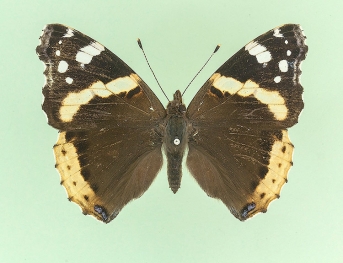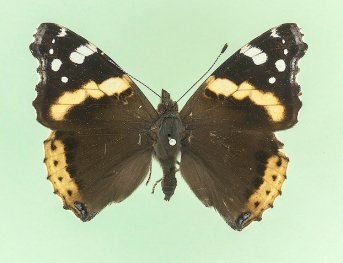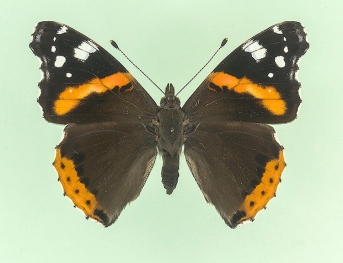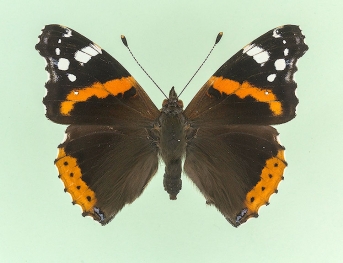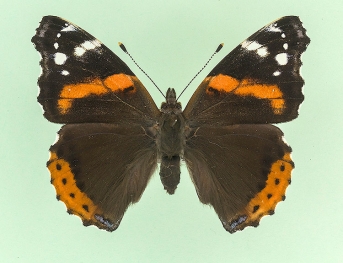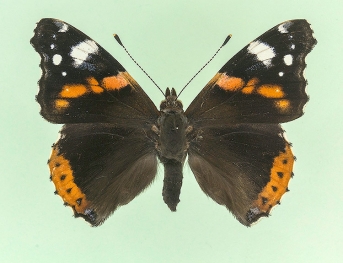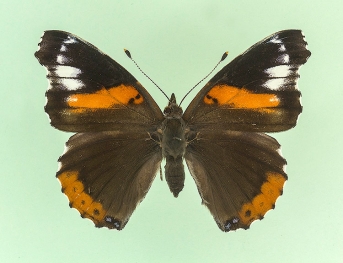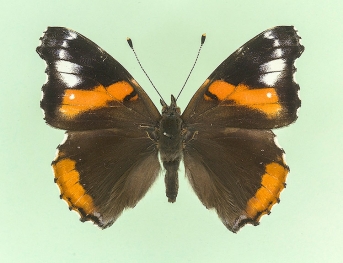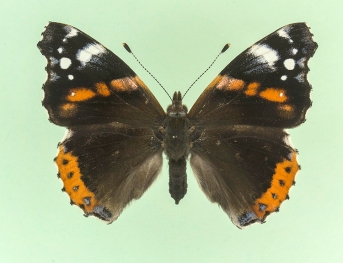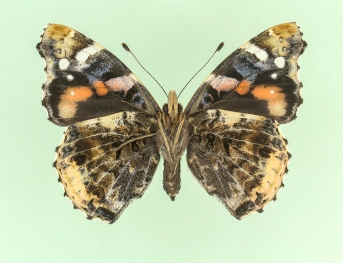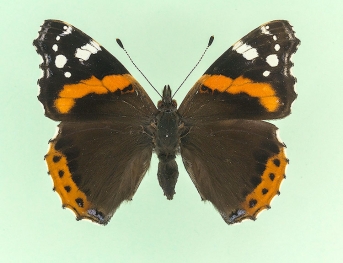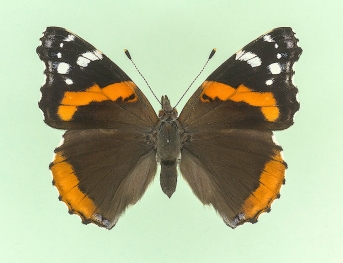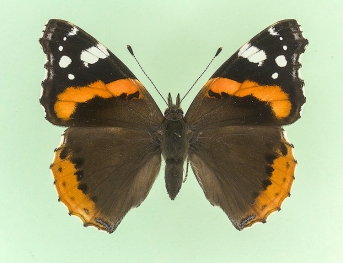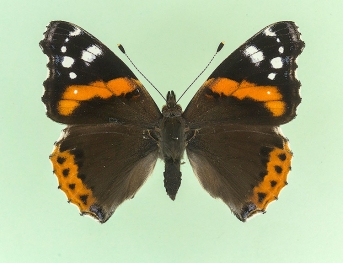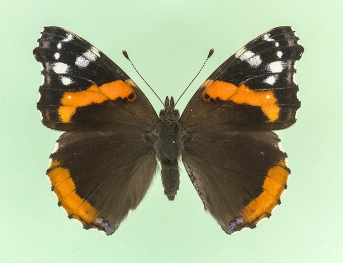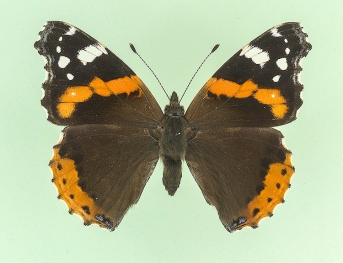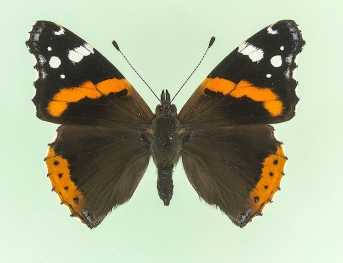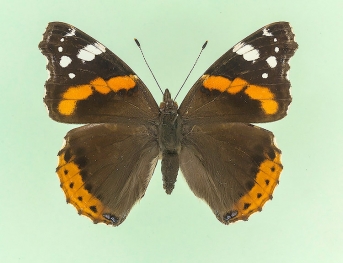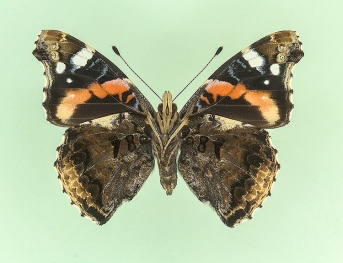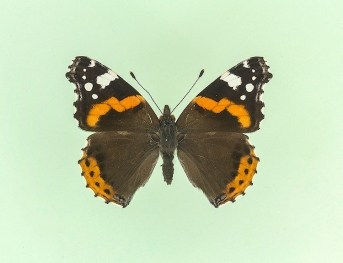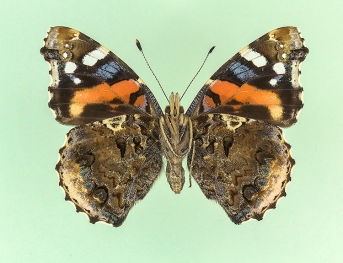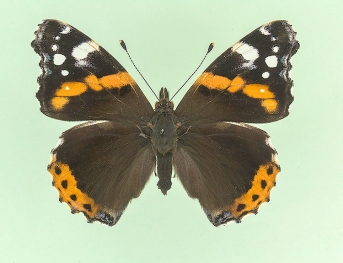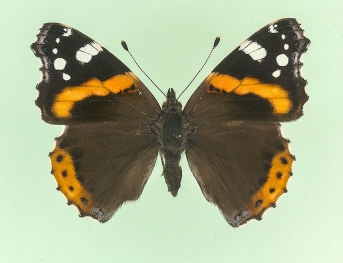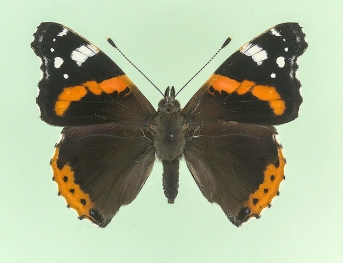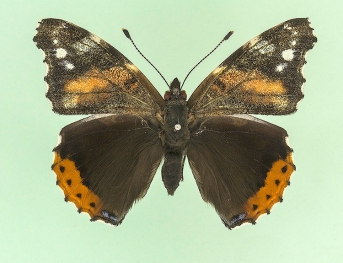Red Admiral Vanessa atalanta
A very beautiful and common species throughout the UK.
Red Admiral Vanessa atalanta - typical recto
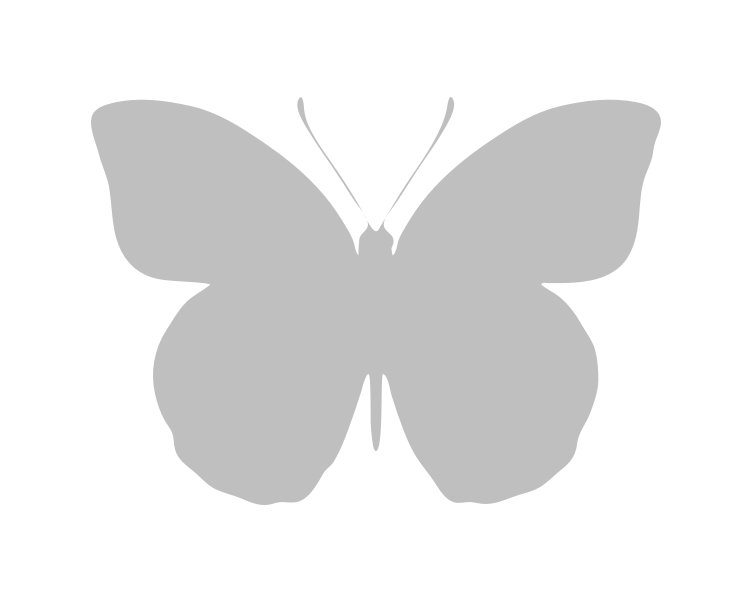
typical recto
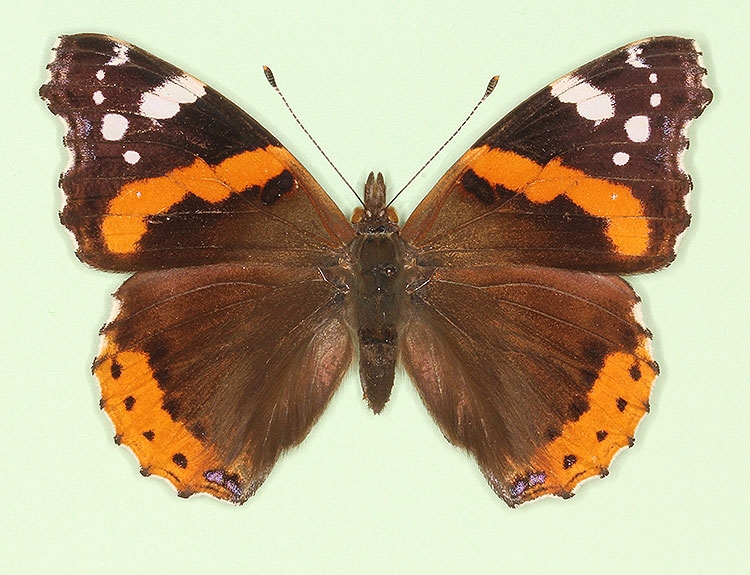
Red Admiral Vanessa atalanta - typical verso

typical verso
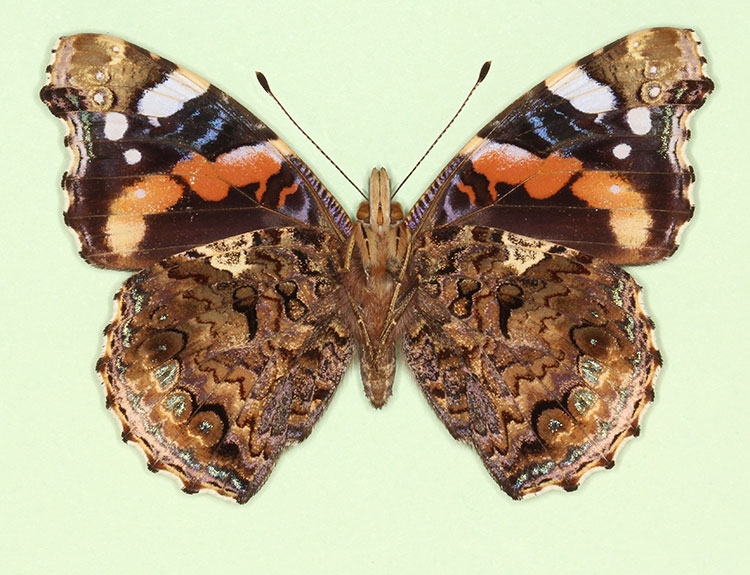
Red Admiral Vanessa atalanta - typical recto

typical recto
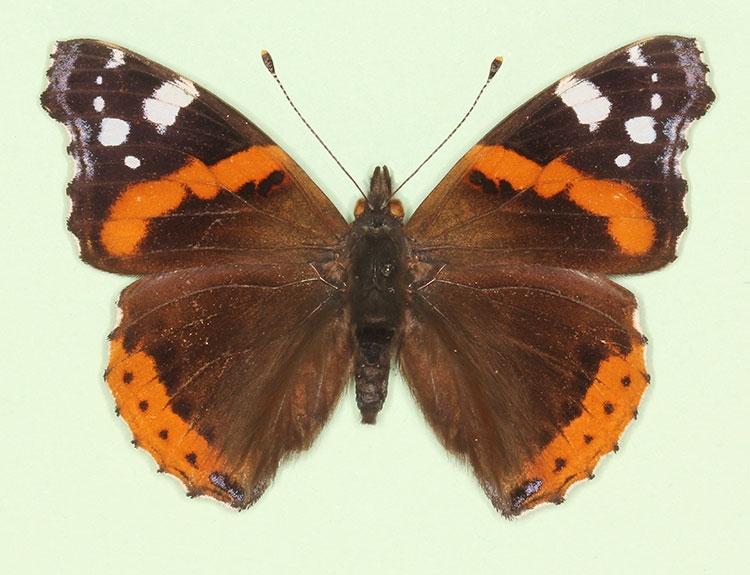
Red Admiral Vanessa atalanta - typical verso

typical verso
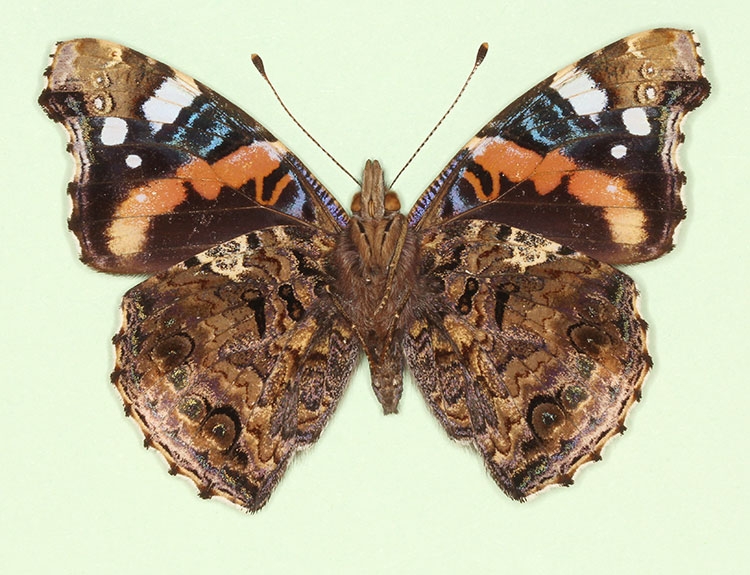
Aberrations
Click on any of the images to view a larger image and comparison specimen.
Red Admiral Vanessa atalanta - millierei

typical recto

ab. millierei Cabeau 1923
The red bands on the forewing replaced with white.
Red Admiral Vanessa atalanta - rosea

typical recto

ab. rosea Reuss 1910
In this example the red bands of the forewings are replaced with a beautiful rose colour on a deep black background. The bands shaded with white near the costa of the forewings, and interrupted with black in the median part.
Blotches in the apex of the forewings pure white and whitish scales seem to be mixed up with the black scales of the ground colour making it seem abnormally transparent when held against a light. The rosy bands then appear almost mauve.
Near the inner margin and close to the bright band there is a whitish blotch or suffusion.
On the hindwings one of the median ocelli should be white centred on the upperside.. This white spot does not seem to occur on this specimen, but I think, none the less that this specimen falls into the description of rosea.
Red Admiral Vanessa atalanta - bialbata

typical recto

ab. bialbata Cabeau 1911
This name refers to the white spot within the red band of the forewings.
This term does not apply to females of this species when it is called ab. ocellata Stammeshaus 1954
Red Admiral Vanessa atalanta - ocellata

typical recto

ab. ocellata Stammeshaus 1954
This name refers to the white spot within the red band of the forewings.
This term does not apply to females of this species when it is called ab. ocellata Stammeshaus 1954
I am not sure from the literature just when the term ocellata and bialbata should be used.
Red Admiral Vanessa atalanta - angustifasciata

typical recto

ab. angustifasciata Lempke 1956
The red band on the forewing of this variation is distinctly narrower than the norm.
Red Admiral Vanessa atalanta - angustifasciata + fracta

typical recto

ab. angustifasciata Lempke 1956 + ab. fracta Tutt 1896
angustifasciata refers to the red band on the forewing of this specimen being distinctly narrower than the norm.
fracta describes the forewing red band being divided in the centre by black scaling that extends along the nervures.
This red bands on this specimens forewings are actually divided by two lots of scaling where there is usually only one division.
Red Admiral Vanessa atalanta - trans ab. klymene

typical recto

trans ab. klymene Fischer 1896
This specimen is transitional to klymene, and is not quite as striking as a true klymene form.
The full description is as follows: Forewings with the main subcostal spot completely absent. In the apical submarginal area there is a series of six large elongated spots in place of the normal row of uneven large and small ones.
The hindwings have very faint spots in the red band.
Red Admiral Vanessa atalanta - klemensiewiczi

typical recto

ab. klemensiewiczi Schille 1896
The main costal spot of the forewing reduced and somewhat obscured and the two lowest white spots of the apical submarginal chain very much enlarged, the bottom one being more than twice normal size, the two together forming a rather large squarish white blotch. Beneath this, in the red band, is a white spot.
The hindwings show a small white spot near the costa, slightly inwards from the red band, and the red band has no black spots
Red Admiral Vanessa atalanta - merrifieldi

typical recto

ab. merrifieldi Standfuss 1895
A very striking example of this fine variation of Vanessa atalanta.
The forewing bands somewhat obscured with black dusting. The main subcostal white spot much enlarged and suffused, with a white streak running from it down to the red band along the costal vein, and a prominent white spot in the red band.
The hindwing blue spots replace the black ones in the red marginal band and small blue streaks on the inner edge of the band running into the black ground in small wedges.
Red Admiral Vanessa atalanta - merrifieldi

typical verso

ab. merrifieldi Standfuss 1895
The forewing bands somewhat obscured with black dusting. The main subcostal white spot much enlarged and suffused, with a white streak running from it down to the red band along the costal vein, and a prominent white spot in the red band. (not shown so well on this specimen)
The hindwing blue spots replace the black ones in the red marginal band and small blue streaks on the inner edge of the band running into the black ground in small wedges.
Red Admiral Vanessa atalanta - turcica

typical recto

ab.turcica Wize 1913
On this aberration there is a little white spot outside the uppermost white spot. This produces a figure reminiscent of the Turkish crescent and star on their national flag
Red Admiral Vanessa atalanta - trans ab. cabeauensis

typical recto

trans ab. cabeauensis Lambillion 1903
The hindwing bands are bereft of all black spots within the red band. In a true cabeauensis the elongated blue patch is also missing.
On the forewings the two lower white spots of the submarginal row are bordered with blue. The larger one on both sides, and the smaller one on its outside only.
Red Admiral Vanessa atalanta - trans ab. cabeauensis

typical recto

An as yet undescribed variation.
The hindwing spots are very much reduced and should make it a transitional form approaching ab. cabeauensis Lambillion 1903
Red Admiral Vanessa atalanta - sordida + ocellata

typical recto

ab. sordida Fritsch 1913 + ab. ocellata Stammeshaus 1954
The ocelli in the hindwing red band are enlarged into the shape of half moons. The ground colour of all wings should be blackish-grey instead of velvety black.
This specimen also has the white spot in the forewings making it an ab. ocellata Stammeshaus 1954
Red Admiral Vanessa atalanta - trans ab. cabeauensis

typical recto

trans ab. cabeauensis Lambillion 1903
The hindwing bands are bereft of all black spots within the red band. In a true cabeauensis the elongated blue patch is also missing.
On the forewings the two lower white spots of the submarginal row are bordered with blue. The larger one on both sides, and the smaller one on its outside only.
Red Admiral Vanessa atalanta - largomarginata

typical recto

ab. largomarginata Gorenendi jk.
The hindwing red band is distinctly broader than normal.
Red Admiral Vanessa atalanta - reducta

typical recto

ab. reducta Lempke 1956
In this variation the forewing has less than five white spots.
Red Admiral Vanessa atalanta - fuscescens

typical recto

ab. fuscescens Lempke 1956
In this variation the overall ground colour of the upper surface is brown black, with the basal side of the forewings a thick black band.
On the inside of the hindwings red band there are a series of black spots.
Red Admiral Vanessa atalanta - infranigrans

typical verso

ab. infranigrans Lempke 1956
The hindwing undersides are nearly completely black with the yellow discoidal spot usually dusted over with black.
Red Admiral Vanessa atalanta - nana

typical recto

ab. nana Schultz 1905
This refers to all dwarf specimens 38-50 mm. The specimen shown is just 40 mm.
Red Admiral Vanessa atalanta - ab. nov

typical verso

Enlarged blue costal area.
Red Admiral Vanessa atalanta - ab.nov

typical recto

This is an unnamed aberration where the forewings are suffused with white scales.
Red Admiral Vanessa atalanta - eos

typical recto

ab. eos Fritsch 1913
The red bands are replaced by orange-cinnabar
Red Admiral Vanessa atalanta - ab. nov

typical recto

Here is an unnamed variation, with a reduced hindwing red band containing only three spots
Red Admiral Vanessa atalanta - scale defect

typical recto

scale defect
This type of imperfection does not have any particular name. There are a great number of problems that an insect can go through during emergence that can cause this problem.
It appears that the wing scales do not lie properly on the surface, usually being deformed in some way to give this appearance.
None the less it is a striking insect due to it being very uniform in appearance.
